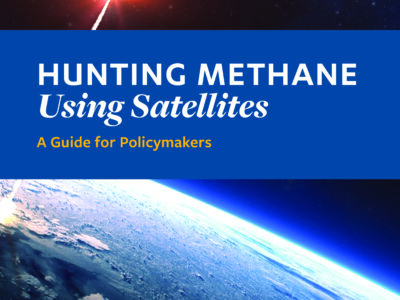Methane
Hunting Methane Using Satellites
Joint UC Berkeley – UCLA Law report aims to help policymakers harness the methane data revolution.
A stream of data about methane—a potent greenhouse gas—is now constantly being beamed down from space. New methane satellites provide a powerful data capability for governments who want to demonstrate leadership in climate policy. To equip policymakers with necessary information on satellite methane data, UC Berkeley Law’s Center for Law, Energy and the Environment (CLEE), …
Continue reading “Hunting Methane Using Satellites”
CONTINUE READINGOne Bright Spot to COP29 in Baku
The outcome of this year’s U.N. climate conference was depressing. But there was some notable news regarding global methane emissions commitments.
Some have described the United Nations Climate Change Conference (COP29) in Baku as “challenging,” “ineffective,” and “disappointing.” On the one hand, global greenhouse gas emissions have reached an all-time high, and the temperature for 2023 is the highest ever recorded. On the other hand, President-elect Donald Trump announced his intention to withdraw the U.S. from …
Continue reading “One Bright Spot to COP29 in Baku”
CONTINUE READINGCPUC Should Set a Date for Closing Aliso Canyon
A proposed decision on the gas facility gives too much deference to SoCalGas regarding the future of gas demand and misses an opportunity to set a clear mandate.
The Aliso Canyon gas storage facility blowout in 2015-16 was the largest methane gas leak in the history of the United States. In addition to the climate effects from the methane leakage — 109,000 metric tons, the equivalent of burning over 1 billion gallons of gasoline — there were tremendous health impacts on neighboring communities …
Continue reading “CPUC Should Set a Date for Closing Aliso Canyon”
CONTINUE READING7 Reasons California Should Get Tougher on Methane from Dairies
California lawmakers should rethink the role of dairy digesters in the state’s dairy and livestock mitigation strategy.
Even though California aims to decrease the emissions of methane, dairy operations are rewarded for creating, and capturing, more and more of the planet-warming super pollutant in the form of manure-derived biogas. Today, California lawmakers declined to correct that perverse incentive, but they still have opportunities to rethink the state’s embrace of digesters as its …
Continue reading “7 Reasons California Should Get Tougher on Methane from Dairies”
CONTINUE READINGThe Unique Legal Context of EPA Methane Regulations
Three separate congressional actions intersect to support the regulations.
The government’s efforts to control methane have followed a complicated path, involving three different congressional actions: section 111 of the Clean Air Act, which allows EPA to regulate emissions of greenhouse gases; a congressional override of an earlier regulatory action; and a newer statute that creates a fee on methane emissions. The upshot is to …
Continue reading “The Unique Legal Context of EPA Methane Regulations”
CONTINUE READINGCOP28: “The Methane COP”
Methane was at the center of COP28. Here are some of the most relevant announcements of this year’s Conference of the Parties.
By far, the most ubiquitous figure at COP28 was that of John Kerry. The U.S. climate envoy strolled through the labyrinthine and confusing alleys of Dubai’s Expo City wearing an impeccable suit despite the almost 100-degree Fahrenheit winter weather of the United Arab Emirates. When he wasn’t walking, he was talking about methane, earning him …
Continue reading “COP28: “The Methane COP””
CONTINUE READINGThe New Frontier of Methane Regulation
Nations, companies, and NGOs are targeting methane like never before using satellite data. A new UCLA paper outlines what that could mean for regulation.
Methane is ready for its close-up. The first week of COP28, the UN climate talks taking place in Dubai, saw a handful of big announcements about how world leaders plan to tackle human-made climate change by targeting methane, a powerful short-term climate pollutant. The UCLA Emmett Institute is also drawing attention to the issue of …
Continue reading “The New Frontier of Methane Regulation ”
CONTINUE READINGLivestock Operations Are Responsible for Over Half of California’s Methane Emissions—Why Won’t CARB Regulate Them?
CARB will have the authority to regulate methane from livestock operations beginning in January but has not initiated rulemaking
At a recent California Air Resources Board (CARB) meeting, a staff member responded to a question about why CARB’s program for reducing emissions from transportation fuels incentivized the capture of methane from landfills so much less than the capture of methane from dairies: “Landfills have a different CI [carbon intensity] score because they are …
CONTINUE READINGMethane Action in 2022: Project Climate’s Year In Review
A short summary of efforts to tackle the super pollutant.
Co-authored with Gil Damon, CLEE Methane Research Fellow. 2022 proved to be a big year for methane—the flammable gas that accounts for 30 percent of Earth’s anthropogenic warming. Methane forms when organic material decomposes in sealed spaces and is released in the agriculture, waste disposal, and energy sectors. In terms of warming, methane is a …
Continue reading “Methane Action in 2022: Project Climate’s Year In Review”
CONTINUE READINGAddressing Livestock Methane in California
New CLEE/UCLA report identifies policy solutions to reduce emissions | Webinar Nov. 10
Methane is a climate super-pollutant that is 80 times more powerful than carbon dioxide over a 20-year period. Given its potency and short life, experts believe that reducing methane emissions is the highest-yield action that governments and businesses can take to curb near-term warming. In the US, livestock are responsible for over one third of …
Continue reading “Addressing Livestock Methane in California”
CONTINUE READING












